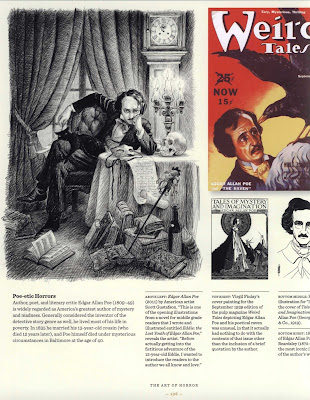The Art of Horror: An Illustrated History
Edited by Stephen Jones
Every year at Christmastime I try and review a 'coffee table' book that offers something noteworthy in terms of being a gift for the sci-fi / fantasy / horror fan.
Some years there's not much to choose from, while in other years, there might be a number of worthwhile candidates.
This year, there is no doubt: the choice is 'The Art of Horror', edited by Stephen Jones.
If you know someone who is a sci-fi, fantasy, or horror fan, then you can be confident they will love seeing this coffee table book under their Christmas Tree.
'The Art of Horror: An Illustrated History' was published in September, 2015 by Applause Theatre & Cinema Books. At 10 x 0.8 x 11.2 inches and 256 pages, this book is too big to fit entirely on my scanner. It's a very well-made hardbound book, with a heavy cloth cover and quality stock paper.
The reproductions of the artwork are high-resolution - even those of long-ago pictures, cinema advertisements, and magazine and book covers.
The book covers the field by topic, rather than chronologically.
The book's format wastes no space - the use of small font allows for several illustrations on each page, with the periodic placement of some striking full-page art here and there throughout the contents.
Readers with any familiarity with horror-themed art and commercial illustrations will undoubtedly recognize more than a few of the images in this book, but there are many that were new to me, and signal that editor Jones, and his contributors, know this material, and the intended readership, very well.
The book's coverage of horror media is primarily centered on the USA and Europe, which may disappoint some readers.[To be fair, however, the field is so large that it probably will take another volume to cover horror art from outside those areas.]
The book covers horror media from the 19th century, on up to the present-day.
As the best books of this type are wont to do, you're sure to see old paperbacks and magazines that you don't have in your collection, and - your interest piqued - you'll be making arrangements to procure that stuff....
Perusing the pages of 'The Art of Horror', I was struck again and again by the inclusion of offbeat, obscure little gems of artwork and illustration. So even hardcore fans of horror art are sure to find novelties throughout the pages of this book.
Summing up, 'The Art of Horror' belongs on every fan's shelf. At $25 or less (not including shipping) from your usual online retailers, this book is good value for the money.....and an affordable purchase, too.
Get it !




















































































